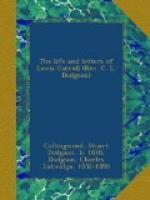Got Professor Clifton’s answer to the “Monkey and Weight Problem.” It is very curious, the different views taken by good mathematicians. Price says the weight goes up, with increasing velocity; Clifton (and Harcourt) that it goes up, at the same rate as the monkey; while Sampson says that it goes down.
On December 24th Mr. Dodgson received the first twelve copies of “Sylvie and Bruno Concluded,” just about four years after the appearance of the first part of the story. In this second volume the two fairy children are as delightful as ever; it also contains what I think most people will agree to be the most beautiful poem Lewis Carroll ever wrote, “Say, what is the spell, when her fledglings are cheeping?” (p. 305). In the preface he pays a well-deserved compliment to Mr. Harry Furniss for his wonderfully clever pictures; he also explains how the book was written, showing that many of the amusing remarks of Bruno had been uttered by real children. He makes allusion to two books, which only his death prevented him from finishing—“Original Games and Puzzles,” and a paper on “Sport,” viewed from the standpoint of the humanitarian. From a literary point of view the second volume of “Sylvie and Bruno” lacks unity; a fairy tale is all very well, and a novel also is all very well, but the combination of the two is surely a mistake. However, the reader who cares more for the spirit than the letter will not notice this blemish; to him “Sylvie and Bruno Concluded” will be interesting and helpful, as the revelation of a very beautiful personality.
You have made everything turn out just as I should have chosen [writes a friend to whom he had sent a copy], and made right all that disappointed me in the first part. I have not only to thank you for writing an interesting book, but for writing a helpful one too. I am sure that “Sylvie and Bruno” has given me many thoughts that will help me all life through. One cannot know “Sylvie” without being the better for it. You may say that “Mister Sir” is not consciously meant to be yourself, but I cannot help feeling that he is. As “Mister Sir” talks, I hear your voice in every word. I think, perhaps, that is why I like the book so much.
I have received an interesting letter from Mr. Furniss, bearing upon the subject of “Sylvie and Bruno,” and Lewis Carroll’s methods of work. The letter runs as follows:—
I have illustrated stories of most of our leading authors, and I can safely say that Lewis Carroll was the only one who cared to understand the illustrations to his own book. He was the W. S. Gilbert for children, and, like Gilbert producing one of his operas, Lewis Carroll took infinite pains to study every detail in producing his extraordinary and delightful books. Mr. Gilbert, as every one knows, has a model of the stage; he puts up the scenery, draws every figure, moves them about just as he wishes the real actors




